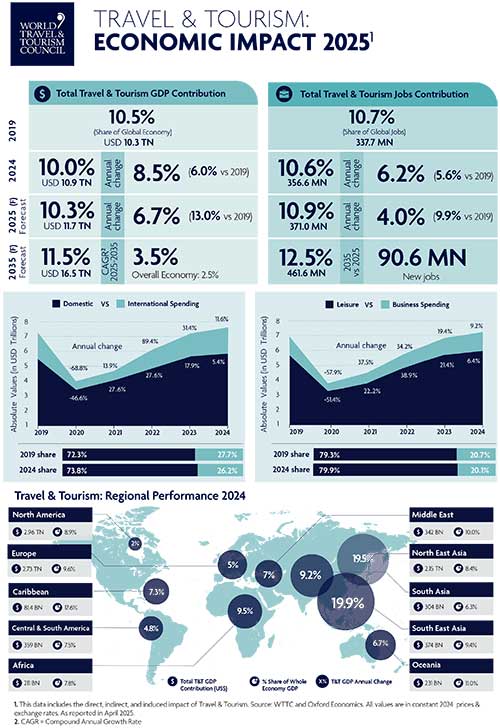
Despite economic headwinds, global tourism is projected to reach a record contribution of USD11.7 trillion in 2025, equivalent to 10.3% of global GDP, according to the latest Economic Impact Research (EIR) from the World Travel & Tourism Council (WTTC).
The report highlights a strong upward trajectory for the travel and tourism sector, which is expected to support 371 million jobs worldwide in 2025, or 10.9% of total global employment—an increase of 14 million jobs from the previous year.
International visitor spending is forecast to hit a record USD2.1 trillion in 2025, surpassing the pre-pandemic peak of USD1.9 trillion in 2019 by USD164 billion.
Domestic visitor spending is also expected to rise to USD5.57 trillion in 2025.
WTTC President and CEO Julia Simpson said the continued prioritization of travel shows strong confidence in the sector’s enduring strength.
She emphasized that demand for travel remains robust despite ongoing global economic challenges.
In 2024, the travel and tourism sector contributed USD10.9 trillion to the global economy, accounting for 10% of GDP.
That figure represented an 8.5% increase from 2023 and was 6% higher than the pre-pandemic level in 2019.
The sector also supported 357 million jobs in 2024, equivalent to one in 10 jobs globally.
International visitor spending rose by nearly 12% in 2024 to USD1.87 trillion, while domestic spending grew 5.4% to USD5.3 trillion.
While the global outlook remains strong, the WTTC notes uneven recovery across regions.
Major markets such as the United States, China and Germany are seeing slower growth compared to emerging leaders.
In the U.S., the world’s largest tourism market, international spending in 2024 remained below 2019 levels and is not expected to fully recover in 2025.
China surpassed pre-pandemic international spending levels in 2024, but growth is forecast to slow this year.
Conversely, Saudi Arabia is outperforming with an ambitious USD800 billion investment plan in the sector by 2030.
European leaders France and Spain continue to see strong tourism numbers, driven by global appeal and sustained investments.
In 2024, North America contributed USD2.96 trillion (8.9% share) to regional GDP and supported 29.7 million jobs (12.3%).
The Caribbean added USD81.4 billion (17.6%) with 2.9 million jobs (15.7%).
Central and South America generated USD359 billion (7.5%) and supported 17.5 million jobs (8%).
Africa’s tourism sector contributed USD211 billion (7.8%) and supported 27.9 million jobs (5.6%).
Europe accounted for USD2.73 trillion (9.6%) with 39.4 million jobs (9.9%).
The Middle East posted USD342 billion (10%) and supported 7.3 million jobs (8.7%).
Asia-Pacific led in employment with 195.8 million jobs (10.3%) and a GDP contribution of USD3.1 trillion (8.4%).
Within Asia, North East Asia contributed USD304 billion, South Asia USD374 billion, and South East Asia USD231 billion.
In 2025, the Caribbean is expected to see the highest year-on-year growth in tourism GDP at 17.6%, followed by South Asia (11%), South East Asia (9.4%) and Europe (9.6%).
Central and South America are projected to grow 7.5%, Africa 7.8%, and North East Asia 6.3%.
From 2025 to 2035, the sector is forecast to grow at an average rate of 3.5% annually—surpassing the global economy’s 2.5% growth.
By 2035, tourism is expected to generate USD16.5 trillion, or 11.5% of global GDP, and support 462 million jobs, one in every eight worldwide.
International visitor spending is projected to reach USD2.9 trillion by 2035, with a compound annual growth rate (CAGR) of 3.4%, while domestic spending is expected to grow 3.3% annually to USD7.72 trillion.
Leisure travel continues to dominate the sector.
In 2024, leisure spending accounted for 79.9% of total tourism expenditure, while business travel made up 20.1%, a slight shift from 79.3% and 20.7%, respectively, in 2019.
WTTC also underscored the need for sustainable growth.
In 2023, the sector accounted for 6.5% of global carbon emissions, reinforcing the importance of innovation and eco-friendly practices.
The WTTC’s 2025 findings highlight the sector’s resilience and essential role in the global economy.
Despite regional disparities, global demand for travel remains strong, positioning tourism as a critical driver of future economic growth.
The council, in collaboration with Oxford Economics, continues to monitor and analyze travel trends across 185 economies.



















